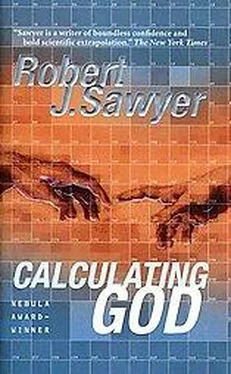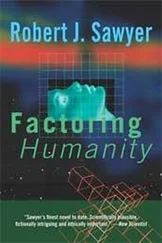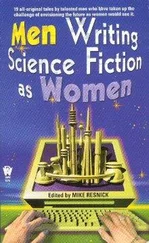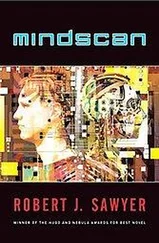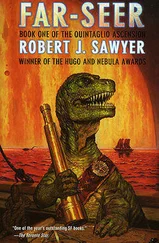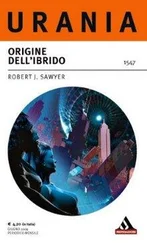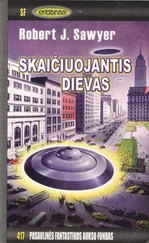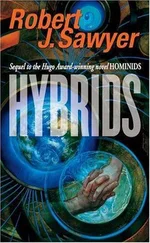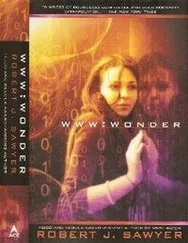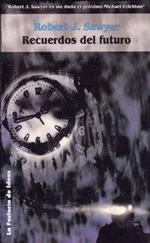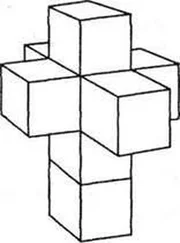Robert Sawyer - Calculating God
Здесь есть возможность читать онлайн «Robert Sawyer - Calculating God» весь текст электронной книги совершенно бесплатно (целиком полную версию без сокращений). В некоторых случаях можно слушать аудио, скачать через торрент в формате fb2 и присутствует краткое содержание. Город: New York, Год выпуска: 2000, Издательство: Tor Books, Жанр: Фантастика и фэнтези, на английском языке. Описание произведения, (предисловие) а так же отзывы посетителей доступны на портале библиотеки ЛибКат.
- Название:Calculating God
- Автор:
- Издательство:Tor Books
- Жанр:
- Год:2000
- Город:New York
- ISBN:нет данных
- Рейтинг книги:5 / 5. Голосов: 1
-
Избранное:Добавить в избранное
- Отзывы:
-
Ваша оценка:
- 100
- 1
- 2
- 3
- 4
- 5
Calculating God: краткое содержание, описание и аннотация
Предлагаем к чтению аннотацию, описание, краткое содержание или предисловие (зависит от того, что написал сам автор книги «Calculating God»). Если вы не нашли необходимую информацию о книге — напишите в комментариях, мы постараемся отыскать её.
Calculating God — читать онлайн бесплатно полную книгу (весь текст) целиком
Ниже представлен текст книги, разбитый по страницам. Система сохранения места последней прочитанной страницы, позволяет с удобством читать онлайн бесплатно книгу «Calculating God», без необходимости каждый раз заново искать на чём Вы остановились. Поставьте закладку, и сможете в любой момент перейти на страницу, на которой закончили чтение.
Интервал:
Закладка:
But to us, to all those who sat in the same vinyl-covered chairs Susan and I sat in then, those who had struggled to take it all in, to understand, to comprehend — to us it was terrifying. My heart was pounding, a splitting headache; no amount of the warm water the specialist kept offering would slake my thirst; my hands — hands that had carefully chiseled embryonic dinosaur bones from shattered eggs; hands that had removed limestone overburden covering fossilized feathers; hands that had been my livelihood, the tools of my trade — shook like leaves in a breeze.
Lung cancer, said the oncologist in even tones, as if discussing the features of the latest sport-utility vehicle or VCR, is one of the most deadly forms of cancer because it usually isn’t detected early, and by the time it is, it has often extensively metastasized to lymph nodes in the torso and neck, to the pleural membrane lining the lungs and chest, and to the liver, adrenal glands, and bones.
I wanted her to keep it abstract, theoretical. Just some general comments, mere context.
But no. No. She pressed on; she made her point. It was all relevant to me, to my future.
Yes, lung cancer often metastasizes extensively.
And mine had done precisely that.
I asked the question I’d been dying to ask, the question I’d been afraid to hear the answer to, the question that was paramount, that defined everything — everything — in my universe from that moment on. How long? How long?
Kohl, at last a human being and not a robot, failed for a moment to meet my eyes. The average survival time after diagnosis, she said, is nine months without treatment. Chemotherapy might buy me a little more time, but the kind of lung cancer I had was called adenocarcinoma — a new word, a handful of syllables I would come to know as well as my own name, syllables, indeed, more defining of who I was and what would become of me than “Thomas David Jericho” had ever been. Even with treatment, only one in eight adenocarcinoma patients are alive five years after diagnosis, and most were gone — that’s the word she used: “gone,” as though we’d slipped out to the corner store for a loaf of bread, as though we’d called it a night, turned in, gotta get up early tomorrow — most were gone much sooner than that.
It was like an explosion, rocking everything Susan and I had ever known.
The clock had started on that autumn day.
The countdown had begun.
I had only a year or so left to live.
11
Hollus and I went down into the Lower Rotunda each evening, after the museum closed to the public. As payment for what I’d let him see, he continued to present recreations of various periods from Beta Hydri III’s geologic past, and I recorded all of these on video.
Maybe it was because my own life was coming to an end, but after a while, I yearned to see something else. Hollus had mentioned the six worlds apparently abandoned by their inhabitants. I wanted to see them, see the most recent artifacts on these alien worlds — the last things the inhabitants had built before they disappeared.
What he showed me was amazing.
First was Epsilon Indi Prime. On its southern continent, there is a huge square, enclosed by walls. The walls are made of giant, roughly hewn granite blocks each more than 8 meters on a side. The area they enclose, almost 500 meters across, is filled with rubble: gargantuan, jagged hunks of broken concrete. Even if one could climb the walls, the vast field of rubble would be imposingly barren. No animal or vehicle could traverse it without great difficulty, and nothing could ever be made to grow there.
Then there’s Tau Ceti II. In the middle of a barren landscape, the long-gone inhabitants had made a disk of fused black stone more than 2,000 meters across and, judging by its edge, more than 5 meters thick. The black surface absorbs heat from its sun, making it incredibly hot; flesh would blister trying to walk across it, and the soles of shoes would melt.
The surface of Mu Cassiopeae A Prime reveals no sign of its former inhabitants; everything has been buried by 2.4 million years of erosion. But Hollus showed me a computer-generated model of what the starship Merelcas’s sensors had revealed beneath the layers of sediment: a vast plain filled with towering, twisted spires, spikes, and other jagged forms, and beneath that, a vault or chamber, forever hidden from view. That planet had once had a very large moon — proportionately, much larger than Luna is in relation to Earth — but it now sported a glorious system of rings instead. Hollus said they’d determined the ring system was also 2.4 million years old — in other words, it had come into existence at the same time the Cassiopeians had vanished.
I had him show me the rest of the planet. There were archipelagos in the seas — islands spread out like pearls on a string — and the eastern shoreline of the largest continent closely matched the western shoreline of the next largest: telltale signs of a world that had been undergoing plate tectonics.
“They blew up their own moon,” I said, surprising myself with the insight. “They wanted to put an end to its tidal forces churning their planet’s core; they wanted to shut off plate tectonics.”
“Why?” asked Hollus, sounding intrigued by my notion.
“To prevent the vault they’d built from ever being subducted,” I said. Continental drift causes crustal rocks to be recycled, with old ones pushed down into the mantle and new ones forming from magma welling up at sea-floor trenches.
“But we had assumed the vault was for the storage of nuclear waste,” said Hollus. “Subduction would actually be the best way to get rid of it.”
I nodded. The monuments he’d shown me here and on Tau Ceti II and Epsilon Indi Prime were indeed reminiscent of designs I’d seen proposed for nuclear-waste sites on Earth: artificial landscapes so foreboding that no one would ever dig there.
“Did you find any inscriptions or messages related to nuclear waste?” I said. The plans for Earth’s waste sites all involved symbolic communication indicating the sort of dangerous materials being stored, so that any future inhabitants of the area would understand what had been buried. The proposed iconography ranged from human faces showing expressions of illness or disgust, indicating that the area was poisonous, to diagrams using atomic numbers to note specifically what elements were interred.
“No,” said Hollus. “Nothing like that. Not in the most recent sites, at least — the ones that I have been showing you from just before the races disappeared.”
“Well, I suppose they could have wanted the sites to go undisturbed for millions of years — for so long that whatever intelligences that later discovered them might not even be of the same species as those who had buried the waste beneath the warning landscapes. It’s one thing to try to communicate the idea of poison or sickness to members of your own species — we humans associate closed eyes, frowning mouths, and protruding tongues with poisoning — but it might be quite another to try to do it across species boundaries, especially when you know nothing about the species that might succeed you.”
“You are not integrating,” said Hollus. “Most radioactive waste has a half-life of less than a hundred thousand years. By the time a new sapient species has emerged, there would be virtually nothing dangerous left.”
I frowned. “Still, they do look a lot like nuclear-waste storage sites. And, well, if the natives of the planets departed to go somewhere else, maybe they felt it was appropriate to bury their garbage before leaving.”
Hollus sounded dubious. “But why then would the Cassiopeians want to stop subduction? As I said, that is the best way to get rid of nuclear waste — even better than firing it off into space. If the spaceship you are using explodes, you can end up with nuclear contamination spread over half your world, but if the waste is carried down into the mantle, it is gone for good. That is, in fact, what my own race ended up doing with its nuclear waste.”
Читать дальшеИнтервал:
Закладка:
Похожие книги на «Calculating God»
Представляем Вашему вниманию похожие книги на «Calculating God» списком для выбора. Мы отобрали схожую по названию и смыслу литературу в надежде предоставить читателям больше вариантов отыскать новые, интересные, ещё непрочитанные произведения.
Обсуждение, отзывы о книге «Calculating God» и просто собственные мнения читателей. Оставьте ваши комментарии, напишите, что Вы думаете о произведении, его смысле или главных героях. Укажите что конкретно понравилось, а что нет, и почему Вы так считаете.
